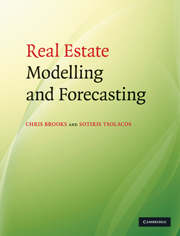Book contents
- Frontmatter
- Contents
- List of figures
- List of tables
- List of boxes
- Preface
- Acknowledgements
- 1 Introduction
- 2 Mathematical building blocks for real estate analysis
- 3 Statistical tools for real estate analysis
- 4 An overview of regression analysis
- 5 Further issues in regression analysis
- 6 Diagnostic testing
- 7 Applications of regression analysis
- 8 Time series models
- 9 Forecast evaluation
- 10 Multi-equation structural models
- 11 Vector autoregressive models
- 12 Cointegration in real estate markets
- 13 Real estate forecasting in practice
- 14 The way forward for real estate modelling and forecasting
- References
- Index
6 - Diagnostic testing
Published online by Cambridge University Press: 05 June 2012
- Frontmatter
- Contents
- List of figures
- List of tables
- List of boxes
- Preface
- Acknowledgements
- 1 Introduction
- 2 Mathematical building blocks for real estate analysis
- 3 Statistical tools for real estate analysis
- 4 An overview of regression analysis
- 5 Further issues in regression analysis
- 6 Diagnostic testing
- 7 Applications of regression analysis
- 8 Time series models
- 9 Forecast evaluation
- 10 Multi-equation structural models
- 11 Vector autoregressive models
- 12 Cointegration in real estate markets
- 13 Real estate forecasting in practice
- 14 The way forward for real estate modelling and forecasting
- References
- Index
Summary
Learning outcomes
In this chapter, you will learn how to
describe the steps involved in testing regression residuals for heteroscedasticity and autocorrelation;
explain the impact of heteroscedasticity or autocorrelation on the optimality of OLS parameter and standard error estimation;
distinguish between the Durbin–Watson and Breusch–Godfrey tests for autocorrelation;
highlight the advantages and disadvantages of dynamic models;
test for whether the functional form of the model employed is appropriate;
determine whether the residual distribution from a regression differs significantly from normality;
investigate whether the model parameters are stable; and
appraise different philosophies of how to build an econometric model.
Introduction
Chapters 4 and 5 introduced the classical linear regression model and discussed key statistics in the estimation of bivariate and multiple regression models. The reader will have begun to build knowledge about assessing the goodness of fit and robustness of a regression model. This chapter continues the discussion of model adequacy by examining diagnostic tests that will help the real estate analyst to determine how reliable the model is and to recognise the circumstances under which OLS may run into problems. These tests enable an assessment of the quality of a model, the selection between models and, in particular, an assessment of the suitability of the chosen model to be used for forecasting.
- Type
- Chapter
- Information
- Real Estate Modelling and Forecasting , pp. 135 - 193Publisher: Cambridge University PressPrint publication year: 2010

